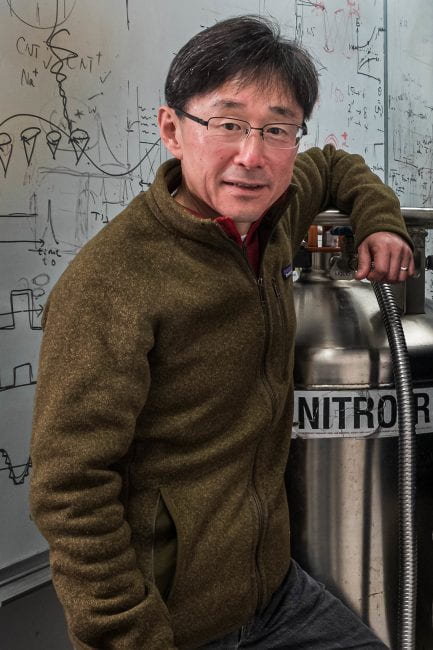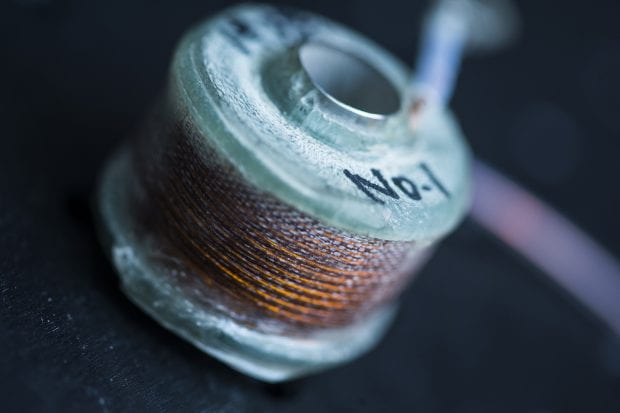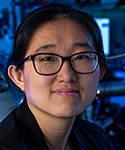RAMBO, short for Rice Advanced Magnet with Broadband Optics, is a unique instrument that engineer, physicist and materials scientist Junichiro Kono created in 2013 in collaboration with colleagues in Japan. RAMBO is a study in extremes, the first device that lets researchers use a wide spectrum of laser pulses to examine the behavior of materials that are simultaneously cooled near absolute zero and subjected to a massive pulse of magnetic energy. Cooled with both liquid helium and liquid nitrogen, the entire device fits atop a single table in Kono’s lab in Brockman Hall.

Armed with a $1.5 million grant from the National Science Foundation, Kono and collaborators are now preparing to create RAMBO-II, a successor capable of producing stronger magnetic fields and probing samples with an even broader spectrum of intense laser pulses.
“Although there are national facilities for producing high magnetic fields, none of them has the capability of performing the types of ultrafast and nonlinear optical spectroscopy experiments that we will be doing on samples exposed to high magnetic fields,” said Kono, the principal investigator on the Major Research Instrumentation grant from NSF’s Division of Materials Science.

The upgrade project teams Kono with magnet designer and builder Hiroyuki Nojiri, the creator of RAMBO’s original 30-tesla pulse magnet, a device no larger than a golf ball that produces a magnetic field about 10 times more powerful that a room-sized hospital MRI machine.
For RAMBO-II, Nojiri’s team at the Institute for Materials Research at Tohoku University in Sendai, Japan, will create three 50-tesla pulse magnets that are about the same size as the original 30-tesla model.
The small magnets are critical for RAMBO, explained Andrey Baydin, a postdoctoral researcher in Kono’s laboratory and an expert in high-field spectroscopy experiments. Baydin played a significant role in preparing the RAMBO-II grant proposal and will be a key member of the team that builds the instrument.
“Magneto-optical spectroscopy experiments can be conducted in strong magnetic fields at many facilities, but the magnets used in those facilities are extremely bulky and have no windows to directly access samples with a laser,” Baydin said. “Instead, light must be sent down long optical fibers before it reaches the sample.”


In spectroscopy, the color of light is more than aesthetic. By investigating the specific spectra, or color, of light that a material emits when it interacts with light or electromagnetic energy, researchers can decipher the motion and behavior of electrons and atoms inside a material. Optical fibers elongate ultrashort laser pulses, changing their color and making certain kinds of spectroscopy impossible.
Baydin said optical fibers aren’t necessary with RAMBO because Nojiri’s magnets are designed to allow several lasers to be directed at samples inside the magnet.
“The size and shape of the magnets is key to coupling strong magnetic fields and ultrashort laser pulses covering a broad range of spectrum from the terahertz to the extreme ultraviolet,” Baydin said.
The first of Nojiri’s 50-tesla magnets will be installed before the end of 2020 in the original RAMBO, which is equipped for terahertz spectroscopy. Nojiri’s other two magnets will be used in RAMBO-II instruments in the laboratories of Rice physicist Ming Yi and Rice materials scientist Hanyu Zhu. In Yi’s lab, RAMBO-II will be outfitted for angle-resolved photoemission spectroscopy, and in Zhu’s lab the platform will employ extreme ultraviolet (EUV) spectroscopy. Yi, Zhu and Rice’s Aditya Mohite are co-principal investigators on the grant.


The smaller its wavelength, the more energy light carries. EUV light packs 10 times the energy of visible light. When its photons strike material, the impact can kick out core electrons and reveal element-specific physical and chemical processes. In RAMBO-II, EUV’s short wavelength will allow researchers to clearly resolve features measuring a few billionths of a meter, the scale of transistors and viruses. RAMBO-II’s EUV source will also be ultrafast, capable of revealing material changes that occur in less than one-trillionth of a second.
A graphic illustrates the setup and functions the Rice Advanced Magnet with Broadband Optics, or RAMBO, a unique instrument that lets researchers use pulsed-laser spectroscopy to examine the behavior of materials that are simultaneously cooled near absolute zero and subjected to a massive pulse of magnetic energy. A $1.5 million grant from the National Science Foundation will allow Rice University researchers to upgrade the instrument with a more powerful magnet and higher frequency pulse lasers. (Photo by Jeff Fitlow/Rice University)

“We will be the first to see electronic and atomic motion in a strong magnetic field with such precision,” Zhu said. “Our experiment will provide key data to the development of new hardware for information technology and materials for renewable energy.”
Kono said RAMBO’s unconventional coupling of magnetism and optics has allowed his group and others, including a number of visiting scientists, to produce new scientific knowledge. RAMBO-II, with its added capabilities, is expected to produce additional breakthroughs that both advance the frontiers of materials physics and chemistry and strengthen Rice’s position as a leader in materials research.
“RAMBO-II will revolutionize optical studies of condensed matter under extreme conditions,” Kono said. “Nothing like it exists anywhere else in the world. It will make Rice a hub for an international network of experimental materials scientists, engineers and applied physicists.”
Kono is the Karl F. Hasselmann Professor in Engineering, chair of Rice’s Applied Physics Graduate Program, a member of the Rice Center for Quantum Materials and a professor of electrical and computer engineering, of physics and astronomy, and of materials science and nanoengineering. Mohite is an associate professor of chemical and biomolecular engineering and of materials science and nanoengineering. Yi is an assistant professor of physics and astronomy. Zhu is an assistant professor of materials science and nanoengineering and of physics and astronomy.
Author: JADE BOYD

